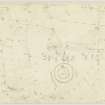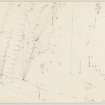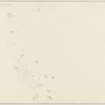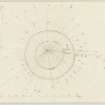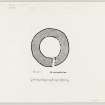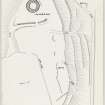Pricing Change
New pricing for orders of material from this site will come into place shortly. Charges for supply of digital images, digitisation on demand, prints and licensing will be altered.
Field Visit
Date 19 April 1957 - 20 April 1957
Event ID 920003
Category Recording
Type Field Visit
Permalink http://canmore.org.uk/event/920003
The remains of an Early Iron Age fort with a later broch built inside it are situated 500 yds west of Craighill farmhouse occupying the west end of a flat-topped spur of land running east and west. From the farm the ground rises very gradually westwards to a height of 441 ft OD at its western extremity where it terminates in a steep rocky face overlooking a sharp bend in the Fithie Burn 100 ft to 150 ft below. The north and south flanks of the spur are steeply inclined and the only easy approach is from the east.
Little now remains of the fort, but it appears to have had an elongated oval shape, measuring approximately 550 ft from east to west by 230 ft transversely within at least three ramparts. The whole of the southeast arc of the defences has been destroyed by cultivation, and on the southwest and west all traces have now disappeared, partly at least as a result of extensive quarrying which has taken place round the northwest face of the spur. On the north side, however, and round the northeast angle the wasted remains of three ramparts, and part of what is probably a fourth, are still visible, the inner one following the edge of the summit area, and the others ranged at intervals down the slope below it. They are all reduced to grassy terraces or mere crest-lines in which intermittent stretches of stony rubble appear. There is no evidence to show whether any of the three tracks that lead through the defences on the north side is similar; they have all been in use in comparatively recent times and are probably associated with the line of quarried rock-faces shown on the plan aligned east to west some 50ft inside the top crest-line.
The broch, accompanied by an outer defensive work to the east of it, lies within 25 ft of the western tip of the spur. Excavations were carried out at the time of visit with the help of Mr DB Taylor and a party of schoolboys from the Harris Academy, Dundee. Before the work began the remains of the broch appeared as a low grass-grown mound through which the tops of a few stones protruded. Sufficient clearance was made to reveal that the broch wall is almost circular, having an external diameter of 65 ft and a thickness of 15 ft, with an entrance facing east. The outer face was cleared down to the level of the natural subsoil on which it rested and was found to be standing to a maximum height of 2 ft in two courses and to be complete throughout its circuit. The foundation course consists, for the most part, of long flat blocks, laid horizontally and measuring up to 3 ft in length by one ft in height. Such stones as remain of the second course are angular and untrimmed, being about 1ft 6 in to 2 ft square, with the gaps between them filled, where necessary, by pinnings of small stones. The inner face is of similar construction, though the size of the stones employed is rather smaller than those in the outer face. The best preserved section uncovered extends immediately south of the entrance, where three well-built courses are visible standing to a height of nearly 2 ft. It was impossible in the time available to attempt to clear the interior of the broch or the entrance passage and the quantity of debris present suggest that several courses of the inner face may still remain buried. The entrance measures 4 ft 3 in at its inner end and the north and south side-walls of the passage were traced outwards for a distance of 8 ft and 9 ft respectively. The south wall appears to be straight while the north wall is slightly concave. At a distance of 5 ft from the inner edge of the north side-wall a narrow opening, 2 ft wide, leads to a mural chamber, the dimensions of which were not discovered. No signs of door-checks are visible. A large block, measuring 5 ft in length by 2 ft in breadth, which lies on top of the debris filling the passage is clearly a dislodged lintel-stone.
The broch is protected to the east, where it is most vulnerable, by an outer defensive work drawing transversely across the summit of the ridge from north to south. It consists of a stone-revetted rampart composed of earth and small stones thrown up from an external quarry-ditch, with an entrance, 13 ft wide, situated in line with that of the broch. South of the entrance the rampart and ditch extend as far as the edge of the natural scarp where they have been partly destroyed by a modern track running obliquely up the slope; north of the entrance only a stretch of 50 ft now survives, but the work must have originally continued to the edge of the north flank of the spur. The rampart stands to a maximum height of 2 ft above the interior and 6 ft above the bottom of he ditch, and would have had a thickness of about 6 ft though it is now spread to as much as 15 ft. Portions of the bottom course of a heavy stone revetment were discovered on the outer edge of the rampart and also along the ends flanking either side of the entrance, consisting of boulders measuring up to 1 ft 6 ins in height and 2 ft in length. Although no facing-stones are at present visible on the inner edge of the rampart, the loose composition of the core-material makes it probably that they existed originally. The ditch, which has a greatest depth of 4 ft below the exterior ground level is partly rock cut and of ragged outline.
Situated 8 ft east of the broch entrance and roughly in line with the south side of the passage there is a boulder protruding through the turf, on the upper surface of which are 15 plain cup-marks, and a number of other possible, concentrated within an area 2 ft by 2 ft 6 in. the cups are of normal size, measuring 1.5 in. to 3 in. in diameter and up to half an inch in depth. None of them is ringed.
Visited by RCAHMS 19-20 April 1957











